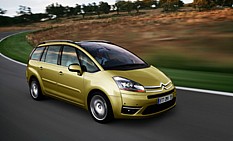Review
| Image gallery - click on thumbnails | ||||||
 |
 |
 |
||||
FOR two cars that share the same name, there’s a world of difference between Citroën’s Xsara Picasso and the C4 Picasso.
Where the Xsara version appears to have used a jelly mould as its design inspiration, the C4 model brings rakish lines and muscular wheelarches; where the Xsara can seat five, the C4 can seat seven, and in terms of quality the Xsara is firmly at the budget end of the pile, unlike the far superior C4.
They’re poles apart in all areas, and while the Xsara version will continue to be sold for the next few years at least, all of the attention will be on the C4 Picasso.
Together, they will account for 30,000 sales in the UK next year, with fleets taking around 50%. Citroën wouldn’t be drawn on exact volumes, instead stating that the Xsara Picasso would still contribute a ‘significant number’ to the mix. Its significantly lower pricetag (£11,250 compared to £14,995 for the entry-level C4) and the appeal of fleet-specific VTX models will certainly help, but there’s enough price cross-over to make many people question whether they want an ageing five-seater mini-MPV or a state-of-the-art model with two extra seats and more equipment.
Ian Hughes, Citroën’s head of fleet and remarketing, said: ‘The C4 Picasso is a seismic shift from the Xsara in terms of quality, but the latter is still a competent member of the family, especially in VTX trim where it makes a strong business offering.’
While the C4 Picasso is positioned to rival the Vauxhall Zafira, Renault Grand Scenic, Volkswagen Touran and Ford S-MAX, Hughes expects fleet drivers to defect from a wide selection of sectors.
He added: ‘Obviously the car will appeal to family buyers, but it straddles lots of sectors and we’ll be looking at drivers of cars like the Audi A4 and Honda Accord – people who want a comfortable, sensible car.
Comfortable and sensible the C4 Picasso certainly is, but it also has many more strings to its bow. I’ve already mentioned the styling, but such is the visual impact of this car that it warrants further words. See it in the metal and it looks really, really good – sleek and understated, yet bold and with some quirky detailing at the same time.
There are hints of the firm’s flagship C6 saloon about it, with intersecting lines and unconventionally-shaped light clusters, while inside it is equally dramatic, with a minimalist dashboard and the fixed-hub steering wheel first seen on the C4.
Staying inside, the seats are, as you would expect, of the fold-flat variety and work simply – they’re all moved through fingertip-light levers and create a completely flat floor. Put them all up and there’s bags of space for the middle-row occupants, although children are the best bet for the rearmost two chairs.
Four engines will be offeredwhen the car goes on sale – two petrol and two diesel.
The 1.8-litre 130bhp petrol and 1.6-litre HDi diesel with 110bhp both come with a five-speed manual gearbox as standard, while the 2.0-litre 145bhp petrol and 2.0 HDi 140 come only with Citroën’s EGS semi-automatic gearbox.
Behind the wheel
WHILE the C4 Picasso is eye-catching from the outside, the visual drama continues inside.
The first thing you notice is the huge windscreen that stretches back into the roof, letting in a vast amount of light. This airy feeling is helped by the dashboard, which removes most of the clutter from the middle – there are just two airvents where the centre console should be. Everything else is dispatched elsewhere – the heating controls are positioned at the far ends of the dash by the doors and most of the stereo and tip computer functions are dealt with via buttons on the steering wheel.
Dominating the dash is a large digital display showing all of the functions. This allows more storage bins to be placed around the cabin – a giant refrigerated coolbox under the dash and two big bins on top in front of the driver and passenger.
I tried the model tipped to be the biggest seller – the 1.6-litre HDi. Although its capacity doesn’t sound much, it offers 110bhp and gives enough power to shift a large vehicle such as this along well.
It’s also very comfortable, thanks to the air suspension system.
The downside is the EGS semi-automatic gearbox on my test car, which gave jerky upshifts, even when the throttle was blended on up-changes. The manul override via paddles on the steering wheel was little better, either.
Verdict
STYLISH, versatile and well equipped – the C4 Picasso ticks every box. The only fly in the ointment is the EGS gearbox, which gives jerky shifts and costs more than a standard manual version. Opt for a 1.6-litre HDi manual and the C4 Picasso makes sense for business and the family.
Fact file
| Model: | 1.8 | 2.0 | 1.6 HDi | 2.0 HDi | ||||
| Max power (bhp/rpm): | 130/6,000 | 145/6,000 | 110/4,000 | 140/4,000 | ||||
| Max torque (lb-ft/rpm): | 125/3,750 | 148/4,000 | 177/1,750 | 200/2,000 | ||||
| Max speed (mph): | 115 | 121 (118) | 112 | 121 | ||||
| 0-62mph (secs): | 11.9 | 11.5 (12.2) | 12.7 (13.4) | 12.5 | ||||
| Fuel consumption (mpg): | 35.3 | 35.3 (31.7) | 47.9 (49.5) | 46.3 | ||||
| CO2 emissions (g/km): | 190 | 190 (211) | 155 (150) | 159 | ||||
| On sale: | January 15 | |||||||
| Prices (OTR: | £14,995–£21,695 | |||||||
Figures in brackets for autos
















